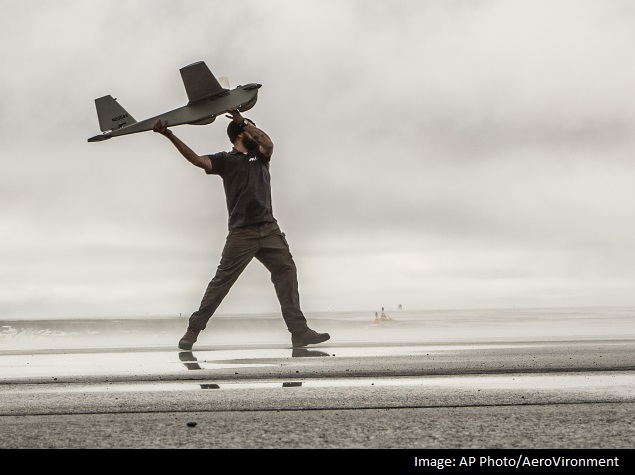- Home
- Others
- Others News
- FAA Approves Commercial Drone Flights Over Land
FAA Approves Commercial Drone Flights Over Land

Drone maker AeroVironment of Monrovia, California, and BP energy corporation have been given permission to use a Puma drone to survey pipelines, roads and equipment at Prudhoe Bay in Alaska, the agency said. The first flight took place on Sunday.
Made by AeroVironment, the Puma is a small, hand-launched craft about 4 1/2 feet long and with a 9-foot wingspan. It was initially designed for military use.
Drones are often less expensive to operate than manned aircraft and easier to maneuver. Equipped with 3D cameras, the Puma will provide images of hard-to-reach places not currently available, BP and AeroVironment say.
AeroVironment CEO Tim Conver said the Puma "is now helping BP manage its extensive Prudhoe Bay field operations in a way that enhances safety, protects the environment, improves productivity and accomplishes activities never before possible."
Last summer, the FAA had approved the Puma and the ScanEagle made by Boeing subsidiary Insitu Inc. of Bingen, Washington, for flights over the Arctic Ocean to scout icebergs, count whales and monitor drilling platforms.
(Also see: Facebook's Connectivity Lab to use satellites, drones to spread the Internet)
"These surveys on Alaska's North Slope are another important step toward broader commercial use of unmanned aircraft," said Transportation Secretary Anthony Foxx. "The technology is quickly changing, and the opportunities are growing."
Last week, the FAA said it was considering giving permission to seven filmmaking companies to use drones for aerial photography, a potentially significant step that could lead to greater relaxation of the agency's ban on commercial use of drones. So far, the only exceptions to that ban have been limited flights that have been approved over the Arctic Ocean and now Alaska.
Congress directed the FAA to provide commercial drones access to U.S. skies by September 2015, but the agency's efforts to write safety rules for such flights by drones have been slow, and it is not expected to meet the deadline. FAA officials are on their third attempt to draft regulations acceptable to the Transportation Department and the White House.
Regulators have said they expect to propose rules before the end of the year intended to clear the way for flights by drones weighing 55 pounds or less. However, it will take months and perhaps years before such regulations become final.
Much of the commercial demand for unmanned aircraft is for small drones, some of which weigh only a few pounds. The FAA estimates that within five years after regulations are in place there will be about 7,500 commercial drones operating in the U.S.
(Also see: Amazon testing delivery packages using drones, CEO Bezos says)
Ben Gielow, general counsel for the Association for Unmanned Vehicle Systems International, a trade association for the commercial drone industry, said the first approval of commercial flights over land is "an exciting moment," but "we believe more can and must be done to allow for limited operations for small (unmanned aircraft) over land."
FAA Administrator Michael Huerta has said drafting such rules is complex because they must ensure that the large volume and diversity of manned aircraft in U.S. skies are protected. Even a small drone that collides with plane traveling at high speeds or gets chewed up by helicopter rotors could cause a crash.
But as the cost of small drones has come down and their sophistication and usefulness has increased, entrepreneurs and businesses - from real estate agents to wedding video makers - aren't waiting for government permission. Drone industry officials have warned that the longer the FAA takes to write regulations, the more rogue commercial operators will multiply.
Catch the latest from the Consumer Electronics Show on Gadgets 360, at our CES 2026 hub.
Related Stories
- Samsung Galaxy Unpacked 2025
- ChatGPT
- Redmi Note 14 Pro+
- iPhone 16
- Apple Vision Pro
- Oneplus 12
- OnePlus Nord CE 3 Lite 5G
- iPhone 13
- Xiaomi 14 Pro
- Oppo Find N3
- Tecno Spark Go (2023)
- Realme V30
- Best Phones Under 25000
- Samsung Galaxy S24 Series
- Cryptocurrency
- iQoo 12
- Samsung Galaxy S24 Ultra
- Giottus
- Samsung Galaxy Z Flip 5
- Apple 'Scary Fast'
- Housefull 5
- GoPro Hero 12 Black Review
- Invincible Season 2
- JioGlass
- HD Ready TV
- Laptop Under 50000
- Smartwatch Under 10000
- Latest Mobile Phones
- Compare Phones
- Honor Win RT
- Honor Win
- Xiaomi 17 Ultra Leica Edition
- Xiaomi 17 Ultra
- Huawei Nova 15
- Huawei Nova 15 Pro
- Huawei Nova 15 Ultra
- OnePlus 15R
- Asus ProArt P16
- MacBook Pro 14-inch (M5, 2025)
- OPPO Pad Air 5
- Huawei MatePad 11.5 (2026)
- Xiaomi Watch 5
- Huawei Watch 10th Anniversary Edition
- Acerpure Nitro Z Series 100-inch QLED TV
- Samsung 43 Inch LED Ultra HD (4K) Smart TV (UA43UE81AFULXL)
- Asus ROG Ally
- Nintendo Switch Lite
- Haier 1.6 Ton 5 Star Inverter Split AC (HSU19G-MZAID5BN-INV)
- Haier 1.6 Ton 5 Star Inverter Split AC (HSU19G-MZAIM5BN-INV)

















